In this article, I will be discussing growing flowers for food in containers that can be used for salads, garnishes, vegetables, desserts, and drinks. They will not only add interest for your dinner plate but also introduce more exotic flavours to your starters, main course and desserts.
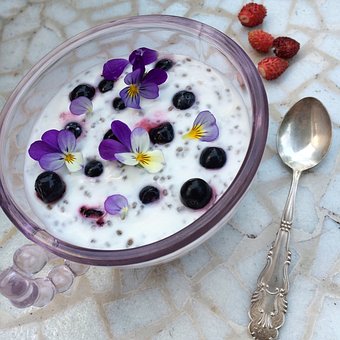
Flowers have been used in our cuisines for thousands of years, with the Chinese using blooms in 3000 BCE, whilst Romans used roses, violets, and lavender in their dishes.
The practice is still going strong, with many restaurants, using flowers in their dishes. The privilege is not restricted to professional chefs, as you yourself can grow edible blooms in your container garden.
HOW TO PREPARE EDIBLE FLOWERS
Edible flowers are at their best when eaten straight from the container garden, especially first thing in the morning before they have had too much sun. If this is not possible, you can put them in a plastic container and store them in a fridge, where they will last a few days.
Before eating, wash and dry them by dipping the petals in a bowl of cold water, and gently shaking them dry. Watch out for any diseased leaves or flowers, and any insects which could be hiding amongst the petals.
In flowers, the petals are the most edible part of the blooms, whilst other parts are not so much so. The heel at the base of the flower, as well as the stamen, pistils, and calyx, need to be removed, as they can be bitter. Pansy flowers, on the other hand, can be eaten whole.
HEED THE FOLLOWING WARNINGS
The following warning must be heeded of all plants before consuming any blooms:
- If you have an allergy to pollen, do not eat edible flowers at all.
- If in any doubt, play safe and do not eat flowers at all.
- Do not pick faded, discoloured, or disease flowers in your container garden.
- Do not treat your edible flowers with pesticides or fungicides. It is not good for your health. If you have plants in pots, cut them back instead to encourage new growth of more new shoots and fresh flowers.
I would recommend good hygiene practices, as I cannot be held responsible for any adverse reaction suffered by eating flowers. Practice caution, as it is better to be safe than sorry.
What follows are flowers that can be used as salads, garnishes, vegetables, desserts, and drinks, when grown in containers. Unless stated all of these plants can be grown in multipurpose compost in full sun.
ACHILLEA MILLEFOLIUM (Yarrow)

The bitter leaves of the yarrow can be eaten raw or cooked, making them ideal for mixed salads. It is best to use when the leaves are young. The flowers and leaves can also be used to make a delicious, aromatic tea.
AGASTACHE FOENICULUM (Giant Hyssop)

The flowers and leaves have a fragrant, delicate flavour, which is ideal to add to cakes to give a slight aniseed flavour. You can add to whipping cream to give a liquorice flavoured dessert topping. Not recommended for pregnant women.
AGAVE AMICA
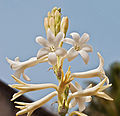
The white flowers can be eaten once they are cooked, and often used in soups or to flavour oriental sauces.
ALCEA ROSEA (Hollyhock)

The large flowers can be crystallized and used to decorate cakes and roulades. They can also be mixed with salad leaves to give a supreme tasting salad. The flower can also be made into a syrup, which can be added to desserts. Before using remove stamens and any green bits.
ALLIUM (Chives/Chinese Chives)

Chive flowers have a mild onion flavour and are very crunchy. They can be tossed in salads, pasta dishes, and egg dishes. Excellent when added to white fish meals or when added to cheese sauces. In order to add to salads, break the flower heads into individual florets and use it that way. Grow in gritty multipurpose compost in full sun.
AMARANTHUS

This very nutritious plant has leaves that are similar in taste to spinach, where it can be used as part of a mixed salad. The seed of the flowers are often used as a grain, and then turned into flour, and then used in savoury or sweet baked dishes. Grow in a non-acidic multipurpose compost in full sun.
ANETHUM GRAVEOLENS (Dill)

The flowers of this herb are great with fish dishes, omelettes or with other cooked vegetables. It can be used whole as a pickling ingredient for gherkins and, onions and beetroot. Grow in gritty multipurpose compost in full sun.
ANTIRRHINUM (Snapdragon)

The multicoloured flowers of his plant can be used as a garnish or dressing on top of salads. It can have a bland taste and is often bitter to eat.
BEGONIA x TUBERHYBRIDA (Tuber Begonia)

This tuber produces brightly coloured flowers that have a lemony taste, which is very crisp in texture. The flowers can be chopped up and used in salads or sandwiches, or they can be mixed with yoghurt to form a delicious dip for a starter.
Remember to only use tuberous Begonia petals, as other varieties cannot be eaten. The petals contain oxalic acid and should only be eaten in moderation, especially for those suffering from gout, kidney stones or rheumatism. Grow in multipurpose compost in light shade.
BELLIS PERENNIS (Bell’s Daisy)

Pull apart the petals of this familiar perennial, where it is an ideal garnish or an ideal dessert ingredient. It has numerous application to savoury dishes including salads and soups. Whilst in desserts it will make a colourful decoration for cakes, biscuits, and mousses.
Do not use if you have asthma or severe allergies, as eating this flower will cause an allergic reaction. Can also be grown in light shade.
BIDENS
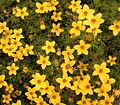
The flowers of this bedding plant are commonly used in salad, but once cooked can be used as a vegetable to many dishes. Will also grow in light shade.
BORAGO OFFICINALIS (Borage)
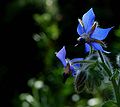
The flowers can be used in savoury or sweet salads. It can also garnish soups or be used as a decorative feature. The flowers themselves have a cucumber-like flavour, where the stamens add a hint of sweetness. Borage can affect pregnant and lactating women, as this can cause breast milk to flow. It is also a mild diuretic, so avoid if you have a sensitive bladder. Grow in gritty multipurpose compost in full sun.
CALENDULA OFFICINALIS (Pot Marigold)

Calendula flowers have a peppery taste that adds a tangy flavour to breads, soups and in salads, where they will make a bright colourful addition. The orange or yellow flowers can be used as an economical substitution to saffron, and used in exactly the same way that saffron would be. Young leaves can be used sparingly in salads. Can also be grown in light shade.
CAMELLIA

The flowers of this shrub can be used as a garnish to salads. In the dry form, it can be cooked and used in Asian Cuisine. Grow this large shrub in ericaceous compost in full sun or partial shade.
CAMPANULA (Bellflower)
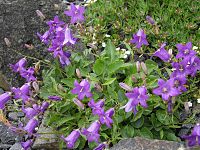
The blue flowers of this perennial can be used in salads, where the colour will contrast the green leaves in the salad very well. Can be grown in partial shade as well/
CANNA LILY

The rhizomes of the Canna lily can be eaten raw, where it has a taste similar to water chestnuts. It can be bitter, so try with caution. You can use it in a similar way to potatoes, where it can be boiled or baked, and used as a vegetable, where the cooked rhizomes taste exactly like a potato. Grow in an enriched multipurpose compost in full sun.
CENTAUREA CYANUS (Cornflower)

Cornflower flowers are not particularly fragrant, but they do have a sweet clove-like taste. It is best to mix with other attractive edible flowers as a colour fountain for salads, omelettes and pasta dishes. It can also be used as a garnish. Can also be grown in the partial shade.
CHRYSANTHEMUM CORONARIUM (Garland Chrysanthemum)

A treat if you fry the petals of the plant quickly in vegetable oil, and then use the resulting crisp petals as an addition to soups, stir-fries, and salads. The taste can be strongly spicy, so use sparingly in salads. Remember that Chrysanthemum coronarium is the only chrysanthemum that is edible, so do not try other varieties. Best grown in sand multipurpose compost in full sun.
CICHORIUM INTYBUS (Chicory)
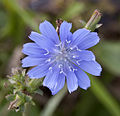
The flowers have a mild lettuce-like flavour that makes a decorative addition to salads. The flowers themselves can be frozen in water and used as an ice cube to add extra flavour to drinks. The flower buds can be pickled and used as a garnish.
Do not use or touch if you suffer from allergies, as the plant can cause contact dermatitis.
CITRUS VARIETIES (Lemon/Lime)

Citrus flowers have an exotic smell and flavour, and has a number of uses in the kitchen. On the savoury side, they add a lemony zing to stir-fries, whilst on the sweet side, it can be used to decorate cakes and desserts. It can also be crystallized and used in many desserts. Grow in citrus-based compost in full sun, mostly indoors in autumn, winter, and spring. Can be left outdoors in summer.
CORIANDRUM SATIVUM (Coriander)

The flowers have as many uses as the leaves, and so can be used in multiple dishes. Can be added to stir-fries o especially cream cheese. For a treat, scatter a few flowers over citrus fruit flowers, as they will intensify flowers. Grow in gritty multipurpose compost in full sun.
COSMOS SULPHUREUS

The colourful blooms add a zing to your meals, where the brightly coloured blooms will be a striking feature. The flowers and young leaves can be made into a mixed salad or used solely as a snack. Please note that only Cosmos sulphureus is edible, the other varieties are totally inedible.
CURCURBITA SPECIES (Courgette, Cucumber, Squash, Pumpkins)

All Cucurbita varieties produce edible yellow flowers that have a sweet taste. The flowers can be stuffed with cream cheese or other fillings and then fried. You can also chop up the flowers and add them to soups and egg dishes.
CROCOSMIA

The flowers produce a yellow dye that is used as a saffron substitute. This dye can be used to add yellow colouring to savoury and sweet dishes. Grow in an enriched multipurpose compost in full sun in a sheltered location.
CYCLAMEN PERISCUM

The leaves of this familiar plant, are often used in Mediterranean and Eastern cuisine. In these countries, the leaves are often mixed with rice and meat in the similar way as green dolmades. Please note that only Cyclamen periscum’s leaves can be eaten. The bulb itself is toxic and should never be eaten under all circumstances. Grow in an enriched multipurpose compost in partial shade.
DAHLIA

One surprising plant where the tubers and the flowers of all varieties are edible. What flavour you get is so much dependent on the soil or compost in which the plant is grown in. The tubers will either have a chestnut like, or sliced apple or carrot flavours. The flower itself will be similarly flavoured.
DIANTHUS (Carnation/ Pinks/ Sweet William)
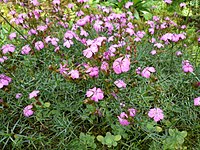
Most Dianthus species flowers, especially those who are most fragrant, have a clove-like taste. They can be used to garnish soups, salads and add a point of interest to a punch bowl. The flowers petals are good as cake decoration, whilst Sweet William flowers, add zest to sorbets, ice cream, fruit salads, and seafood sauces. Remove the white heel of the petals, as this part is bitter to eat.
ERUCA VESICARIA (Rocket)

The flowers and leaves of this herb have a spicy peppery flavour, and are delicious added to salads, rice or sprinkled over cooked beans. Delicious if served upon brown toast. Grow in gritty multipurpose compost in full sun.
ERYSIMUM (Perennial Wallflower)
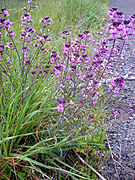
This perennial has tender young shoots that can be eaten as a vegetable, once cooked. It is a shame that the flowers cannot.
ESCHSCHOLZIA (Californian poppy)

The leaves can be used fresh or dried to make a tisane, which is both soothing and relaxing.
FRAGARIA (Strawberry)
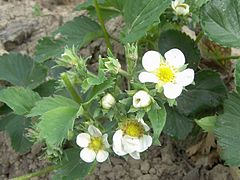
The flowers have a mild strawberry flavour, where the petals can be added to summer drinks, where it will float on top of them. Grow them in an enriched multipurpose compost in full sun.
FREESIA
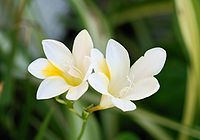
The flowers of this bulb can be infused into a tisane with lemon juice and lemon zest. The peppery flavour adds bold colour to the drinks and will act as a pick me up. Grow in sandy multipurpose compost in full sun.
FUCHSIA
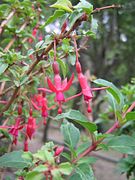
The flowers of this shrub are very colourful and come in many different and elaborate shapes. You can use it in fruit or green-leaved salads, where they would make a colourful addition. Can be crystallized or added individually to jellies.
The fuchsia berries make excellent jams. To eat remove all green and brown section, along with the stamens and pistils. This will enhance the petal flavour, otherwise, it can be bitter. Grow in an enriched multipurpose compost in full sun.
GERANIUM (Scented Pelargonium)

The leaves when crushed emits a citrus fragrant that will add flavour to cakes and meringue-based desserts. The flowers are not as strongly scented but are ideally crystallized and scattered on desserts.
GLADIOLUS (Gladioli)
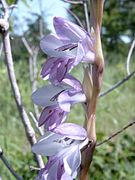
The multicoloured attractive flowers have a similar taste to lettuce. They make a lovely receptacle for sweet or savoury spread or mousses. Use the flowers individually in mixed salads, where the colour will really stand out. Remove the anthers, and middle section of the blossoms before consuming.
GYPSOPHILIA (Baby’s Breath)

This perennial with its delicate white or pink blooms have a mild, sweet flavour. It is perfect as a garnish for dessert dishes.
HEMEROCALLIS (Daylily)
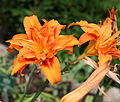
The daylily petals taste great in salads or soups. It can be cooked and served as a vegetable or added as a stir-fry ingredient. You can also stuff the large flowers with any filling you prefer and fry them. Only hemerocallis can be eaten as it is not a true lily, other types of Lilium are highly poisonous. Avoid at all costs.
HESPERIS MATRONALIS (Sweet Rocket)

This flower combines well with poultry dishes and fish dishes. Can also be made into a flavoursome tea. Prefers to be grown in the shade.
HEUCHERA (Coral Flower)
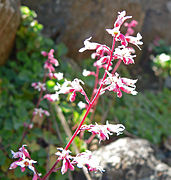
The colourful leaves of this perennial add extra interest to mixed green-leaved salads. You need to eat with other less bitter leaves, as the Heuchera leaves can be too tangy. It will make bland salads more colourful and exciting. Can also be grown in the shade.
HIBISCUS
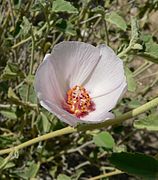
The flowers can be infused in boiling water to make a citrus flavoured tea. Best to use the petals by themselves in fruit salads. Be warned the plant has high pollen and can cause an allergic reaction to sufferers.
HOSTA

The best part of the plant is the rolled-up leaf as it emerges in spring. Small rolled up leaves can be fried for a few minutes and are good in stir-fries. The thicker leaves are better boiled and eaten as a vegetable in a side dish. Grow in a moisture retentive multipurpose compost in partial to total shade.
HOUTTUYNIA CORDATA (Fish Wort)

The leaves are best added to salads to make a beautiful orange flavoured meal. Do use it sparingly as it can be overpowering to other subtle flavours. Can be grown in full sun or partial shade. Is very forgiving as it will grow in dry or moist composts.
HYSSOPUS OFFICINALIS (Hyssop)

The flowers are ideal added to soups or salads, but also can be used as a complement to fish and meat dishes. If you love your teas, infuse some flowers with boiling water to make a refreshing treat.
IBERIS (Candytuft)
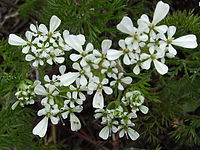
The leaves and flower of this plant can be eaten raw and will add a broccoli-like taste to your salads.
IMPATIENS WALLERIANA (Busy Lizzie)

The familiar flower of multicolours look attractive when used as a garnish in salads or floating on top of cold drinks. Grow in an enriched multipurpose compost in full sun or partial shade.
LAVANDULA (Lavender)
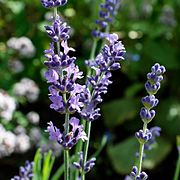
There are many uses of lavender flowers in both savoury and sweet dishes. You can make a delicious lavender sugar, which can be added to biscuits, jams or jellies. The flowers can be added to vegetable stock, where it goes great with poultry and lamb dishes. Grow in a well-drained sandy multipurpose compost in full sun.
LOBULARIA MARITIMA (Alyssum)

The leaves and flowers add a pungent flavour to salads, which is similar to kale. Can be added to soups and omelettes.
MAHONIA
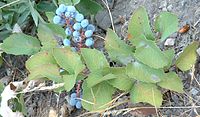
The acidic grape-like fruits can be stewed with sugar and made into jellies or pie-fillings. They can be mixed with other mild flavour fruit to give a zingy fruity mixture. Will make an interesting lemonade-like drink, which must be tried. The leaves themselves can be cooked and eaten as a snack.
MALUS (Apple)

Apple blossoms have a floral taste, and the petals make a beautiful addition to salads. Can be added to whipping cream or ice cream to give an extra dimension to your apple pie. Looks stunning when floating on top of a fruit punch bowl.
MATTHIOLA (Stocks)

The perfumed flowers are usually added to salads, or they can garnish any desserts. They can be candied and used to give colour and flavour to many desserts. Can be grown in full sun or partial shade.
MESEMBRYANTHEMUM (Livingstone Daisy)

The leaves are edible in this summer bedding plant, where it can be eaten raw. It is often used as a spinach substitute in salads.
MELISSA OFFICINALIS (Lemon Balm)

The small flowers are ideal for adding to salad dressings or soups, where the lemon flavour would add zing to the dishes. You can also make a stuffing from the flowers, which are excellent with poultry dishes. Grow in a well-drained gritty multipurpose compost in full sun.
MENTHA (Mint)

The strong flavoured tiny flowers pack a punch and add a real zing to green salads, fruit salads, fresh fruits, chocolate mousses or chocolate cakes. Excellent as a sauce to flavour lamb dishes. Grow in gritty multipurpose compost in full sun.
MIMULUS (Monkey Flower)

The leaves can be eaten either raw or cooked, where it has a slight bitter tang to them. The leaves act as a lettuce substitute in salads, where the leaves will add a point of interest. Will do best in the shade.
MONARDA (Bergamot)
The colourful petals have a sweet, spicy flavour, where it will enhance salads. It can also be used to create stuffings and jellies, where it goes well in rice and pasta dishes.

The leaves make a deliciously flavoured tea (think earl grey), where it can be used fresh or dried. Do not soak them in water too long as this will diminish the flavours. Grow in an enriched multipurpose compost in light shade.
MUSCARI
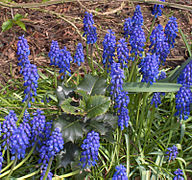
The blue flowers make an interesting addition to many meals when sprinkled over desserts, where it has a delicate flavour.
MYOSOTIS (Forget Me Not)
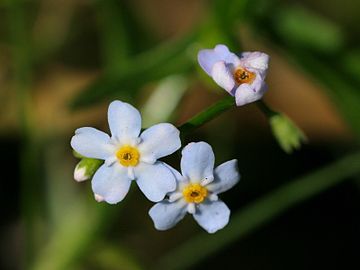
The blue flowers can be eaten as a snack on its own, or it can be tossed into salads. Other uses include using the flowers as a garnish or as a decorative feature on top of cupcakes. Can be grown in light shade.
MYRRHIS ODORATA (Sweet Cicely)

The sweet aniseed-flavoured flowers are a lovely addition to fruit tarts and pies, in particular, apple, plum or rhubarb. Grow in a well-drained gritty multipurpose compost in full sun.
NEPETA CATARIA (Catmint)

The small flowers have a strong minty spicy flavour and should only be used sparingly when cooked. Can be used in pasta, rice or vegetable dishes. Excellent as a complement to meat dishes. If you are pregnant, avoid catmint as there is a possible interaction with the baby.
NIGELLA (Love in a Mist)
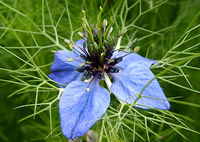
The seed of the plants has multiple uses, where its spicy taste can be used as a condiment or spice, to flavour breads, cakes, and even curries. Can tolerant light shade.
OENOTHERA (Evening Primrose)

These biennial flowers have a taste similar to lettuce, which makes a colourful addition to any green salad, where a yellow element is introduced.
OCIMUM (Basil)

Basil flowers have many uses as the leaves themselves and can be substituted when the recipe called for basil leaves. Use the strong tasting flowers more sparingly, where it tastes good in salads and tomato dishes. Grow in gritty multipurpose compost in full sun.
ORIGANUM (Oregano /Marjoram)

The flowers are added to tomato dishes where they give a wonderful flavour. You can add it when making your own bread, which can be spread with oregano butter. This is made by mixing oregano and butter together and then re-freezing. Grow in a gritty multipurpose compose in full sun.
OSTEOSPERMUM (African Daisy)

The flowers that are so brightly coloured, can be used as a garnish to many dishes. They can be frozen in an ice cube, where it will be a talking point in parties in summer drinks.
PERILLA FRUTESCENS (Korean Basil)

The whole flower can be eaten, where they will add a spicy flower to stir-fries, but especially in chicken or fish dishes. Grow in gritty multipurpose compost in full sun.
PHASEOLUS COCCINEUS (Runner Bean)

Flowers can be eaten raw in salads where their mild bean flavour, can add subtle tones. It can be also cooked and mixed with runner beans to make a colourful bean salad. Only red flowers are recommended for eating and not the white one.
PISUM SATIVUM (Pea)
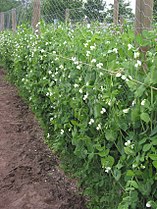
The flowers of the pea are slightly sweet and add taste exactly like a pea, where it makes an interesting addition to salads.
The shoots and vine tendrils can also be used in salads, where they will impart their pea flavour. Do not use sweet peas which are a totally different plant, as they are toxic.
PHLOX PANICULATA (Perennial Phlox)

This colourful perennial produces masses of flowers that have a slightly spicy taste. They can be used in fruit salads or mixed with other petals to make a floral salad.
You can crystallize the small flowers and use them to decorate cakes and other baked goods. The perennial phlox is the only variety that is edible, creeping phlox and annual phlox are inedible. Grow in an enriched multipurpose compost in full sun.
PRIMULA (Polyanthus, Cowslip, Primrose)
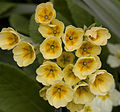
These flowers are popular as a garnish on many salads, where the stalks need to be removed in order to impart their sweet taste. The flowers can be crystallized and used in pancakes or as a cake decoration. The wide range of colours available will make any cake special so use these flowers on special occasions such as birthday and weddings. Grow in enriched multipurpose compost in full sun or partial shade.
PRUNELLA (Self-Heals)

The young leaves of this perennial and its stem can be eaten raw in salads. The whole plant can be boiled and eaten as a vegetable.
PULMONARIA
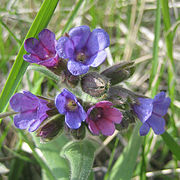
The leaves can be eaten raw and added to salads, or they can be cooked as used as a vegetable. The plant is an ingredient in dry vermouth. Grow these plants in multipurpose compost in the shade.
ROSE (Rosa)
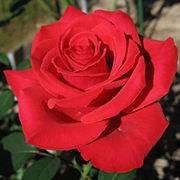
As a general rule if arose has a strong pleasant smell then it will also taste good. Petals have a delicate flavour which will improve cool drinks and fruit dishes, they can even be turned into jams and jellies. They will make an attractive cake decoration if they are crystallized. The whole heel needs to be removed from the flower base before it can be eaten. Grow in an enriched multipurpose compost in full sun.
ROSMARINUS OFFICINALIS (Rosemary)

The small blue flower and stems can be used with pork or poultry dishes, where they will impart an intense flavour. You can add some flower to you baking mix to make a flavour intensive biscuit. Grow in gritty multipurpose compost in full sun.
SALVIA OFFICINALIS (Sage)

Flower taste similar to the leaves and make a vibrant contribution to salads. They can be infused into mustard and vinaigrettes. Grow in gritty multipurpose compost in full sun.
SALVIA SCLAREA (Clary)

This pastel coloured plant has flowers that are very aromatic. They will give a lovely contrast to green lettuce leaves in salads.
TAGETES (Marigold)

The flowers and leaves have a citrus-like flavour, which makes them ideal for salads, sandwich filler, seafood dishes or hot desserts. Marigolds can be harmful if consumed in large amounts, so should be eaten infrequently.
TRAGOPOGON PORRIFOLIUS (Salsify)

The root which is the plant main feature has a nutty taste. The young leaves are used in salads where they also have a nutty flavour. The flower buds should be picked before it opens and whilst young, where they can be lightly cooked. Once cold the flower buds can be used in salad or as a garnish.
SANTOLINA (Cotton Lavender)

The leaves that are so fragrant can act as a condiment to flavour soups and broths.
TROPAEOLUM (Nasturtium)
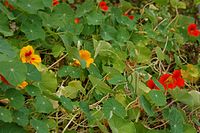
The leaves and flower have a peppery flavour that can be described as similar to watercress. The peppery flavour adds spice to salads, whilst the green seed pods can be used in a similar way to capers. Excellent when added to tomatoes in sandwiches or mixed with cream cheese in canopies.
TULIPA (Tulip)

The flowers of a tulip have a sweet pea-like flavour, which is also crisp in texture. Whole flowers can be stuffed with shrimp or chicken salad. You must remove pollen and stigmas from the base before stuffing. The petals can be added to salads and sandwiches to give plenty of colour. Be warned some people suffer allergic reactions to tulips, where simply touching them will cause a rash to appear. Do not eat the poisonous bulb.
VIOLA (Pansy and Violets)
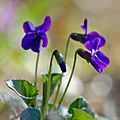
The colourful flowers of this perennial have a lettuce-like flavour, and will make a decorative addition to any green salad. It will also make an interesting garnish to many dishes, or it can be crystallized and used to decorate cakes, cookies or other desserts.
CONCLUSIONS
In this article, we have been on a comprehensive journey around the flower container garden, to see what can be eaten. What you have discovered are there are a wide range of plants that can be eaten which are commonly found in the garden. This should cover a wide range of people’s tastes and should start you salivating at the prospects.
No matter what there is a container plant that you can use as a salad, garnish, vegetable, dessert or drink ingredient. Why do not you try to grow your own edible flower container garden today?
If you want to tell me about your floral eating adventures, or if you have a question, please do so below.
Happy flower snacking.

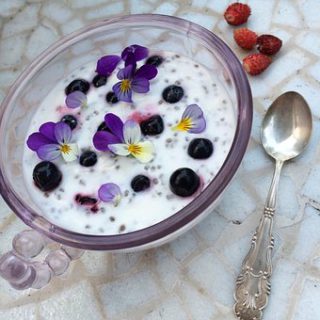
This is an absolutely lovely article! Although I have grown many of these flowers for ornamental purposes (and a few I knew to be edible) this has definitely expanded my repertoire.
The pictures definitely are a great aid for flower/plant identification and I appreciate your well thought out descriptions as to the taste profile of each. What a beautiful way to enhance both the flavour and taste of your foods. I have used rose blossoms and hips very successfully to make a lovely wine as well as rose water for various Indian recipes. The uses are veritably endless and are not just limited to salads! Sangria anyone?
This article is a definite keeper for those who wish to expand upon their culinary experiences and experimentation.
Hi Feochadan
Thank you for those kind words and I want to write a comprehensive article on edible flowers, which will give both gardeners and cooks a different aspects to both. I hope I have got your gastric juices flowing with the ideas suggested here.
Thank You.
Antonio
I’ve seen well-known chefs using flowers in their salads and I wanted to give it a try myself. I have allergies in the pollen of 3 plants but I know exactly which ones. Do you think that eating the flowers of other plants could be bad for my health?
Also, what’s your take on microgreens? They are becoming more and more popular and they are considered a superfood.
Hi Harry
As said in the article, people with allergies should not eat any pollen containing plants, as your life could be in danger, so better to play safe. As for microgreen I am all in favour as they are easy to grow.
Thanks for the comment
Antonio
This is great! I love container planting – this year I did it with direct seed . So much fun when everything starts to germinate. Glad I found this blog – loving it; Thanks for the helpful tips on how to prepare edible flowers. It will be a selfish thing if I don’t share this to my friends.
Thanks again.
Hi Jordan
It is always best to share the love, as we all need to broaden our eating habits. I am glad you enjoyed the article as it was a pleasure to write.
Thanks
Antonio
I have definitely learnt something new today. I was always of the impression that putting flowers the fridge can actually weaken the flower which would make it look like it doesn’t have much life because of the cold. If I do this what temperature would you suggest would be ideal for this?
Hi Jay
Normal fridge temp of 5 degrees Celsius should be sufficient for your flowers but as said in the article it is best to consume within 3 days. It is best to eat the flowers freshly picked from the garden, for an extra zing.
Thank you for commenting
Antonio
Thanks for a very thorough list of edible flowers. There were several there that I had not heard of before.
I’ve cooked a lot with pumpkin flowers before. They are lovely deep fried. I’m thinking of decorating a chocolate cake with flowers. What kind do you recommend and what should I keep in mind to ensure they look good when the cake gets to the table?
Hi Sara
A lot of the flowers that I recommend can be used for cake decoration, my personal favourites are roses and hollyhocks, which look excellent on cakes. If they are crystallised then it will make them extra special
Thank you for the interest.
Antonio